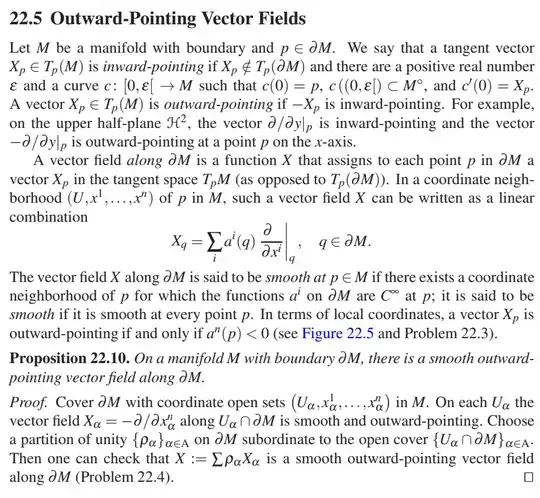My book is An Introduction to Manifolds by Loring W. Tu. The following is an entire subsection (Subsection 22.5) of the section that introduces manifolds with boundary (Section 22, Manifolds with Boundary).
Note: I believe that all manifolds with or without boundary referred in this subsection have unique dimensions by some convention (either it's implicit, or it's explicit a I missed it) in the section, contrary to the convention of the book (See here and here).
Questions:
According to an errata by Ehssan Khanmohammadi, the only erratum to be made in this subsection is that $c((0,\varepsilon[) \subset M^\circ$ should be changed to $c(]0,\varepsilon[) \subset M^\circ$. I still have several concerns about this subsection.
What exactly is a vector field along $\partial M$, and what is its domain?
- Asked here.
For the local expression of $X$, a vector field along $\partial M$ is the following understanding correct?
- Asked here.
Is this a correct understanding of the smoothness definition?
- Asked here.
$ \ $
Despite the title of the subsection, I don't think there's a definition for outward-pointing vector fields. What is it exactly?
Choice 1: An outward-pointing vector field $X$ is a vector field on $M$ such that for each $p \in \partial M$, $X_p$ is an outward-pointing tangent vector. In this case and if vector fields along $\partial M$ are defined with domain $M$ (see question 1), an outward-pointing vector field is not necessarily a vector field along $\partial M$.
Choice 2: An outward-pointing vector field $X$ is a vector field on $\partial M$ such that for each $p$ in the domain of $X$, which is $\partial M$, $X_p$ is an outward-pointing tangent vector. In this case and if vector fields along $\partial M$ are defined with domain $\partial M$ (see question 1), an outward-pointing vector field necessarily is a vector field along $\partial M$.
Choice 3: An outward-pointing vector field $X$ is a vector field along $\partial M$ such that for each $p$ in the domain of $X$ (see question 1), if $p \in \partial M$, then $X_p$ is an outward-pointing tangent vector. In this case, an outward-pointing vector field necessarily is a vector field along $\partial M$, by definition of outward-pointing vector field regardless of the domain defined for a vector field along $\partial M$ (see question 1).
Choice 4: other
In the proof of Proposition 22.10, is it understood that we cover $\partial M$ by restrictions of the $(U_{\alpha}, x^1_{\alpha}, ..., x^n_{\alpha})$'s like in questions 2 and 3? (i'll repeat below, so this question will be self-contained.)
Namely: 1. Consider each $p \in \partial M$. 2. View $p \in M$. 3. Obtain a $(U_p, x^1_p, ..., x^n_p)$ for each $p$. 4. Restrict the $(U_p, x^1_p, ..., x^n_p)$'s to $U_p \cap \partial M$ to get $(U_p \cap \partial M, x^1_p|{U_p \cap \partial M}, ..., x^n_p|_{U_p \cap \partial M})$. 5. Since $\partial M$ is Lindelöf since all manifolds without boundary are Lindelöf, we can get a countable subcollection of the $(U_p, x^1_p, ..., x^n_p)$'s to restrict to $U_p \cap \partial M$. There are also other ways to cover $\partial M$. (If $\partial M$ were compact, then we could have a finite subcollection) Hence we have that the cover is indexed "$\alpha$" in some index set $A$ ($\alpha \in A$) instead of specifically by $p$ in $\partial M$.
Update: I think the answer is negative. But here I assume that Tu is following the same convention as Munkres (this is the convention introduced in the section on compact spaces):
For a topological space $X$, $\{U_{\alpha}\}_{\alpha \in A}$ is a cover (an open cover) of $X$ if $X = \bigcup_{\alpha \in A} U_{\alpha}$ and $U_{\alpha}$'s are subsets (open subsets) of $X$.
For a topological subspace $Y \subseteq X$, we still have that $\{V_{\alpha}\}_{\alpha \in A}$ is a cover (an open cover) of $Y$ if $Y = \bigcup_{\alpha \in A} V_{\alpha}$ and $V_{\alpha}$'s are subsets (open subsets) of $Y$
But we have that $\{W_{\alpha}\}_{\alpha \in A}$ is a cover (an open cover) of $Y$ by subsets (open subsets) of $X$ if $Y \subseteq \bigcup_{\alpha \in A} W_{\alpha}$ and $W_{\alpha}$'s are subsets (open subsets) of $X$.
Therefore, it is correct that we do not expect $\partial M = \bigcup_{\alpha \in A} U_{\alpha}$, but we still say $\{U_{\alpha}\}_{\alpha \in A}$ is a cover of $\partial M$ because $\partial M \subseteq \bigcup_{\alpha \in A} U_{\alpha}$ and $U_{\alpha}$'s are subsets of $M$
Actually, based on Lee's Problem 8-4 (mentioned here), I think we can interpret Proposition 22.10 without the concept of "along" as follows:
On a manifold $M$ with boundary $\partial M$, there is a smooth vector field $X$ on $M$ such that each $X_p$ is outward-pointing for $p \in \partial M$.
Is that correct?
I really think there is no need for the concept of "along" here because from $X$'s being a vector field on $M$, we have $X_p \in T_pM$ whether $p \in \partial M$ or $p \in M^\circ$. I could be wrong. Unless we somehow expect $X_p \in T_p(\partial M)$, I think "along" does not seem to add anything new here. Of course the concept of "along" is new if we're talking about generalizing from vector fields $Y$ "on" $\partial M$ to vector fields $Y$ "along" $\partial M$, as may have been the case in the paragraph before Proposition 22.10 (see question 1). But for Proposition 22.10 specifically, I think the concept of "along" can be omitted.
